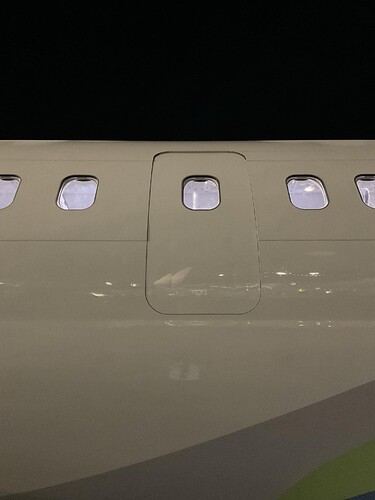Oof. Boeing not doing so good again.
If you want to fly somewhere, go Boeing.
If you want to come back again afterwards, fly Airbus.
Low cycle airframe - delivered 31 Oct 2023 - looks like the “optional” emergency exit decided to part company?
Very lucky indeed that this didn’t happen at say 36,000 ft with a much larger pressure differential.
Rule One - wherever you sit as pax in an aircraft, keep your seat belt on!
Yep. Apparently because this setup had first class, it meant they didn’t need these extra exists in this config.
So they essentially just ‘plug’ the hole where you would otherwise put a door. From the inside, you wouldn’t even know you were sat next to it! Except, well, you’d know if it blew off…
The ATC audio for this event annoys me, as per usual far too much waffle and not getting to the point (Mayday/PanPan)
Was this the pilot requesting lower altitude, and being told to level off, then again asking to descend because of depressurisation and the ATC having to ask if they are declaring or not? It sounded like a bit of a mess.
American ATC is a mess frankly.
Their procedures are lax as poop
Certainly for UK / EU, Mayday call, tell ATC what you are doing, turn off track if applicable / possible (considering safety altitude), squawk 7700, commence emergency descent.
Now, from 16,000 ft, the pax aren’t going to die from hypoxia even without using the drop down masks, flight crew on oxygen, perhaps no need for emergency descent.
The a330 i was on today was a bit rough,
The [door plug has been found](Alaska Airlines plane had warnings days before mid-air blowout Alaska Airlines plane had warnings days before mid-air blowout - BBC News) which will certainly help the investigation. Interesting effects on the flight deck too!
Is that the airline had data warnings from the aircraft systems or was it an airworthiness directive from Boeing and they continued to use the aircraft.
Think it was prior warning(s)?
Pressurisation niggles are not necessarily the easiest things to troubleshoot. Some computers working together (or not) to control the cabin pressure with associated sensors - if one has a momentary “spike,” it can cause an alert that will lock in. After initial technical look see on the ground, no fault found, computers / system reset.
If it happens again, change one black box, go fly again.
Unless the technical analysis has a clear pointer to a specific faulty item, it can be quite hard to pin down.
A fault could relate to physical or electronic sensors, & the reading levels are not that high compared to other systems / structures. Most aircraft systems will cater for slight variations in flow - normally it’s air in (from whatever system generates it - for example, the B787 doesn’t use engine air) balanced by letting air out at a controlled rate to maintain the desired pressure. It’s not a sealed can by any means. The lower the cabin altitude, the better it is for the pax - less fatigue, etc. I think that the B787 is set for about 6000 ft, whereas you can be at at 8000 ft on others types, Obviously, lower cabin altitude = greater pressure differential = more stress on the airframe. There are normally pressure relief valves if the system over-pressurises.
Their “rule book” may have rightly said no ETOPS until issue resolved (or no further reoccurrences after X flights).
CVR completely overwritten as it was only running on a 2h re-write cycle. Apparently this is pretty standard in America. The NTSB chair goes on to call out the FAA for not doing something about this. As it’s caused problems in the past too.
(Start at 21:40, should be where it starts with the link)
This starting to sound as if it is a manufacturer build standards and quality control issue, not for the first time at Boeing.
Tim Clarke at Emirates comments.
I was looking at a last minute escape to Iceland this weekend to try to see the Northern Lights, as the weather is meant to be good and flights + accommodation reasonable.
The only viable flight option would have been on a 737 Max, so I’ve decided to postpone the idea.
I don’t really blame you.
Especially that they’ve now also confirmed they have found loose hardware during the inspections of other aircraft…
Pretty much aviation standard - if you don’t pull the circuit breaker (if you actually have that option) - keeping power on the aircraft (in-flight obviously) or using ground power to investigate a fault = the 2 hr loop will be over-written.
I don’t think that any Max 9 are operating in UK? Turkish Airlines maybe?
No, but it’s sort of starting to show systemic failings within Boeing/Spirit Aero that maybe calls into question how bad the QC actually is.


